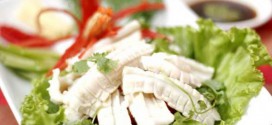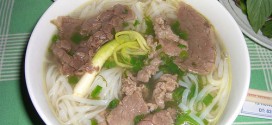Vietnam is one of those countries that has all the recipes that are bound to disconcert most Europeans. However, most of these specialties are expensive luxuries which you are hardly likely to eat by accident. A Western foreigner undoubtedly requires some courage to eat grilled dog, roast cat, mouse, snake or silk caterpillars, but when these dishes are skilfully cooked they really are something special.
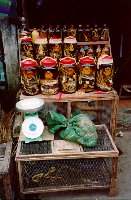
Medicinal or aphrodisiac qualities are attributed to many of these specialties. This has led to the development of veritable gastronomic rituals. The most exciting is probably the snake meal. The still beating heart is swallowed, as is the blood, with rice liquor. Subsequently the snake is elaborately cooked and eaten. The more poisonous the snake, the more beneficial to your health and the more expensive it is. You can also stick to taking snake medicine or – highly recommended – drinking snake liquor. If these specialties do not appeal to you, you can content yourself with everyday Vietnamese food; you won’t be disappointed.
In Vietnam there is never any need to search long for something to eat, the streets are lined with all sorts of restaurants and hot-food stalls. The large cities now offer practically everything. You can choose between foreign and Vietnamese food, expensive and cheap restaurants, between modern, air-conditioned rooms and little stalls at the side of the street consisting of nothing but a table and a coal stove.
The restaurants and street stalls are full at virtually all times of the day. City-dwellers have breakfast on the street, enjoying soup or sticky rice with egg. At midday, people eat ‘people’s rice’ or ‘dust rice’, as they call the food sold by the cheap stalls on the street corner. In the evening it is common to meet up with friends and acquaintances. Even if you don’t go for a meal, then at least you will have a drink together. The young men sit in Bia Hoi (beer gardens), the girls at the Che stands sipping at a dessert-like drink made of dried fruit, coconut cream or sweetened bean paste.
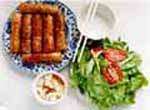
By contrast, the choice is rather limited in the countryside, although the Vietnamese culinary trademarks – pho (noodle soup) and nem (spring rolls) – are available everywhere.
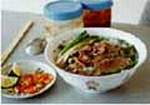
For a long time there was little to eat in Vietnam, and meat was a rarity. So it is not surprising that meat dishes are now extremely popular. Vegetables are for the poor. Thus, if you are a guest, you must be given only the best, which usually means the meat with the most fat. If as a foreigner you go out to dinner and order vegetables, you are likely to be regarded as stingy. For if you are a foreigner you must be rich, and rich people don’t eat vegetables if they can avoid it, surely?
And don’t be worried about formalities when eating. Vietnam isn’t Japan. As long as you don’t stick the chopsticks vertically into the rice (a deadly omen, for the ancestors are offered incense sticks in this way), almost anything goes!
In a Vietnamese house, you sit on the floor or on the large family bed. If you are celebrating – and visitors are always a cause for celebration in Vietnam -several meat dishes, fish and river creatures, soup, salad and fruit will be prepared. Each person helps him- or herself with chopsticks and eats from a separate little bowl.
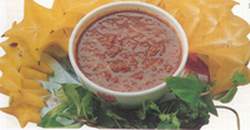
Rice or rice noodles are only served after the meal, just to fill you up. Each dish is based on the famous – or notorious – fish sauce nuoc mam. If this is not strong enough for you, you should try the crab paste, mam tom, mam tep, which can be smelled for miles.
And don’t forget: meals are never dry. You are always offered beer and rice liquor, either pure or flavored with herbs. And not only the men drink. The women also often enjoy a few glasses of herb liquor, with the reassuring excuse that it is healthy. In Vietnamese it is therefore called ruou thuoc (medicine wine). Beer has recently become the second national beverage next to rice wine. Foreign beers like Heineken, Carlsberg, Tiger or Henniger are available, but the home-grown beers like 333 or Bia Hanoi are also popular and of good quality. Coca Cola has managed to conquer the Vietnamese market too, although it hasn’t yet quite displaced the wonderful fruit drinks like coconut milk.
And when you can no longer eat or drink any more, there is green tea.
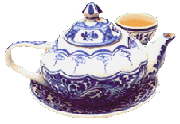
 Vietnamese Culture and Tradition
Vietnamese Culture and Tradition 
